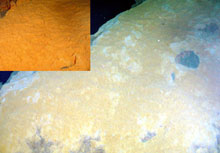
These fluffy yellow and orange microbial mats were seen at the Yellow Top diffuse-flow venting site. The mats are up to 20 cm (8 in) thick and cover an area of approximately 10 sq m (12 sq yd). The inset (upper left) is a close-up of a mat showing its wispy filamentous texture. Notice how the orange color is enhanced in the close-up, as reds do not reflect as well through seawater. This is actually closer to the true color of the mat. Click image for larger view.
Fluffy and Flocculent Microbial Mats at NW Eifuku Volcano
April 12, 2004
Craig L. Moyer
Associate Professor, Biology Department
Western Washington University
![]() Around some of the sea-floor hot springs at NW Eifuku volcano. (mp4, 4.9 MB)
Around some of the sea-floor hot springs at NW Eifuku volcano. (mp4, 4.9 MB)
![]() See the orange bacterial mats of northwest Eifuku volcano. (mp4, 5.3 MB)
See the orange bacterial mats of northwest Eifuku volcano. (mp4, 5.3 MB)
By far the most extensive microbial mats discovered during the 2004 Ring of Fire expedition have been those found at NW Eifuku Volcano. These microbial mats (mainly composed of bacteria) are easily distinguished into two general categories. The first and most often seen are the yellow and orange “fluffy” microbial mats. These fluffy mats occur at many of the diffuse-flow venting sites, which generally have only moderately warmer temperatures than the ambient (surrounding) sea water. These mats can also be recognized by their ability to form “bacteria balls” that can be seen slowly rolling downslope after their production in heavily laden mat fields like Yellow Top. They can also be extruded from nearby cracks and fissures from especially steep areas of diffuse venting.
This “ball effect” is a common characteristic of bacteria that produce mucopolysaccharides (a complex sugar polymer made with sulfuric acid). These particular microorganisms use the mucopolysaccarides to help capture vent fluid nutrients (or their food), which in this case are reduced iron and sulfur compounds. The microbes also use the mucopolysaccarides to keep the oxygen concentration low near their cell surfaces. This allows the bacterial cells to optimize the amount of energy that they can extract from this chemosynthetic process.
Sometimes these mats also form mounds. The mounds are covered with a thin crust and small chimneys that are byproducts of this oxidation process, which is similar to the formation of rust. The thin crust acts much like a thermal blanket, retaining the heat along with the vent fluid nutrients. Similar types of microbial mats have been identified at Loihi Volcano in Hawaii, where they were dominated by iron-oxidizing bacteria.
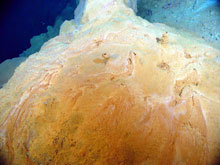
Yellow and orange microbial mats form a “bioreactor” mound with a thin crust and small chimneys on top. The crusty outer coating acts as a thermal blanket to elevate the internal temperature from diffuse venting and help retain reduced microbial nutrients. This mound is approximately 1 m (3 ft) across. Click image for larger view.
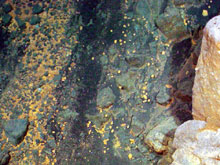
“Bacteria balls” are forming on the left and and rolling downhill on the right. These microbial mats are similar in composition to those seen at the Yellow Top Vent site. The balls range from 1 to 5 cm (1/2 to 2 in) in diameter. Click image for larger view.
The second category of microbial mats seen at NW Eifuku are the white flocculent (loosely held together) mats that are present in and around the high-temperature and extremely gas-rich vents, such as the Champagne Vent site. These are most likely dominated by sulfur-cycling bacteria. Due to the extreme nature of their habitat, many of these bacteria often grow where no macrofauna (like shrimp and mussels) dare to venture. On the edges of these sites, however, where seawater mixes with the otherwise poisonous vent fluids, macrofauna can be seen vigorously feeding upon the microorganisms. This demonstrates the transfer of chemosynthetically derived energy up the food chain to support large communities of macrofauna. Similar microbial mats have been witnessed at Axial Volcano on the Juan de Fuca Ridge, where they were dominated by a diverse community of bacteria known to both oxidize and reduce multiple sulfur compounds.
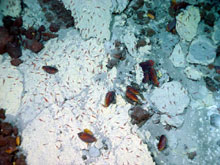
Large numbers of vent shrimp and mussels feed on the white flocculent mats on the periphery of white smokers, showing that microorganisms are channeling energy up the food chain. Click image for larger view.
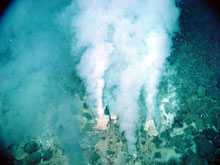
White flocculent mats in and around the extremely gassy, high-temperature (>100°C, 212°F) white smokers at Champagne Vent. Click image for larger view
Sign up for the Ocean Explorer E-mail Update List.



























